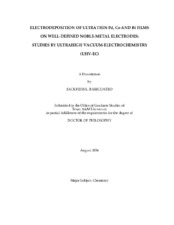| dc.description.abstract | Three illustrative cases involving the electrodeposition of ultrathin metal
films of varying reactivities onto noble-metal substrates were investigated: (i) Pd
on Pt(111), a noble admetal on a noble-metal surface; (ii) Bi on Pd(111), a less
noble admetal on a noble-metal surface; and (iii) Co on polycrystalline Pd and
Pd(111), a reactive metal on a noble-metal surface. The interfacial
electrochemistry of these prototypical systems was characterized using a
combination of electrochemical methods (voltammetry and coulometry) and
ultrahigh vacuum electron spectroscopies (Auger electron spectroscopy, AES;
low energy electron diffraction, LEED; and X-ray photoelectron spectroscopy,
XPS).
Potential-controlled adsorption-desorption cycles of aqueous bromide
exerted surface smoothening effects on ultrathin Pd films with defect sites
(steps). This procedure, dubbed as electrochemical (EC) annealing, constituted a
nonthermal analogue to conventional annealing. EC-annealed ultrathin Pd films
exhibited long-range surface order and remained free of oxygen adspecies. Pdadatoms occupying step-sites were selectively dissolved and/or rearranged to
assume equilibrium positions in a well-ordered (1x1) film.
Electrodeposition of Co was found to be highly surface-structuresensitive.
While virtually no Co electrodeposition transpired on a clean Pd(111)
surface, Co was voltammetrically deposited on (i) a Pd(111) electrode
roughened by oxidation-reduction cycles; and (ii) thermally annealed
polycrystalline Pd, which is a composite of the (111) and (100) facets.
Electrodeposition of Co was also observed to be kinetically hindered and slow
potential scan rates (0.1 mV/s) were required.
Well-defined ultrathin Bi films were potentiostatically electrodeposited
onto Pd(111); a Stranski-Krastanov growth mode was indicated. The
electrochemical reactivity of ultrathin Bi films was characterized using two
surface probes: aqueous iodide and D-glucose. (i) Exposure of the prepared Bi
adlayers (ΘBi 0.33) to aqueous iodide gave rise to (√3x√7) I-on-Bi superlattice.
The same superlattice was obtained if Bi was electrodeposited onto
Pd(111)(√3x√3)R30o-I. (ii) With respect to electrooxidation of D-glucose on
Pd(111), the presence of Bi adlayers inhibited the by-product-induced "surface
poisoning" of Pd(111) but reduced its electrocatalytic efficiency. | en |


